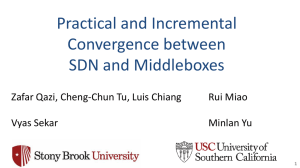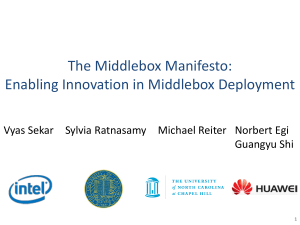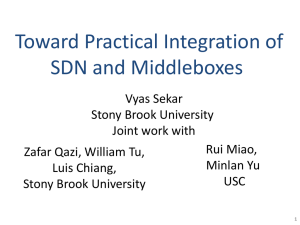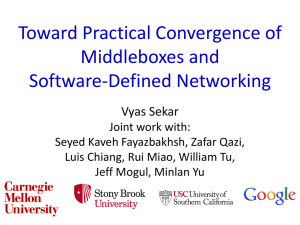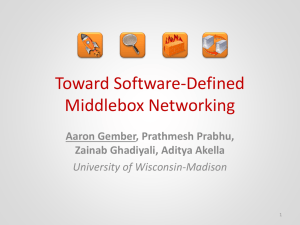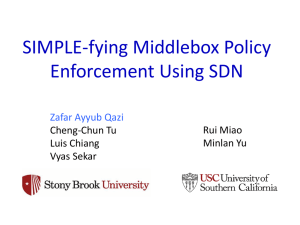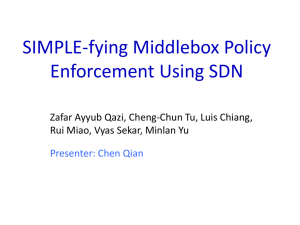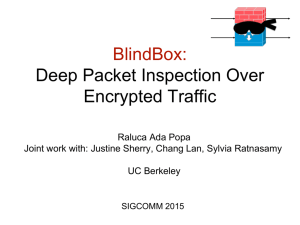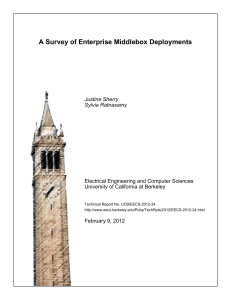SDN: Extensions Middleboxes Ack: Vyas Sekar, Aaron Gember, Felipe Huici, Zafar Qazi 1
advertisement
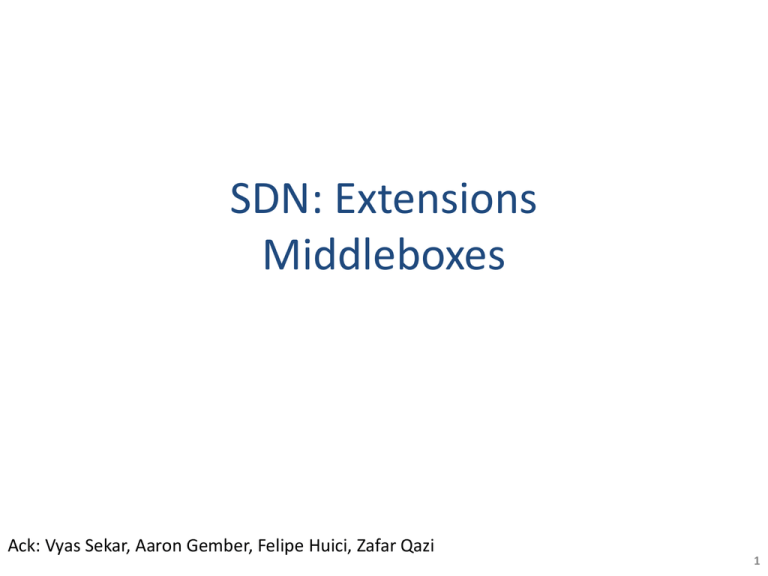
SDN: Extensions Middleboxes Ack: Vyas Sekar, Aaron Gember, Felipe Huici, Zafar Qazi 1 Need for Network Evolution New applications Evolving threats Performance, Security, Compliance Policy constraints New devices 2 Network Evolution today: Middleboxes! Type of appliance Data from a large enterprise: >80K users across tens of sites Just network security $10 billion Number Firewalls 166 NIDS 127 Media gateways 110 Load balancers 67 Proxies 66 VPN gateways 45 WAN Optimizers 44 Voice gateways 11 Total Middleboxes Total routers 636 ~900 3 How many middleboxes do you deploy? Typically on par with # routers and switches. How do administrators spend their time? Most administrators spent 1-5 hrs/week dealing with failures; 9% spent 6-10 hrs/week. Firewalls Proxies IDS Misconfig. Overload 67.3% 63.2% 54.45% 16.3% 15.7% 11.4% Physical/ Electrical 16.3% 21.1% 34% Key “pain points” Narrow Management Management Management interfaces Specialized boxes “Point” solutions! Increases capital expenses & sprawl Increases operating expenses Limits extensibility and flexibility 6 SDN Stack App Runtime Applications Controller Control Flow, Data Structures, etc. Controller Platform Switch API (OpenFlow) Switches 7 Outline • Why middleboxes? • SIMPLE • OpenMB • Slick 8 Can SDN simplify middlebox management? Centralized Controller Web Firewall IDS Proxy “Flow” FwdAction … … Proxy OpenFlow “Flow” FwdAction … … IDS Scope: Enforce middlebox-specific steering policies Necessity + Opportunity: Incorporate functions markets views as important 9 What makes this problem challenging? Centralized Controller Web Firewall IDS Proxy “Flow” FwdAction … … Proxy OpenFlow “Flow” FwdAction … … IDS Middleboxes introduce new dimensions beyond L2/L3 tasks. Achieve this with unmodified middleboxes and existing SDN APIs 10 SIMPLE overview Web Firewall IDS Proxy Policy enforcement layer for middlebox-specific “traffic steering” Legacy Middleboxes Flow Action … … Flow Action … … OpenFlow capable 11 Challenge: Policy Composition Policy Chain: Firewall S1 * IDS Proxy Firewall IDS Proxy Oops! Forward Pkt to IDS or Dst? S2 Dst “Loops” Traditional flow rules may not suffice! 12 Challenge: Resource Constraints Firewall Proxy Space for traffic split? S2 S1 S3 S4 IDS1 = 50% IDS2 = 50% Can we set up “feasible” forwarding rules? 13 Challenge: Dynamic Modifications User1: Proxy Firewall User2: Proxy User 1 Proxy S1 User 2 Proxy may modify flows S2 Firewall Are forwarding rules at S2 correct? 14 New dimensions beyond Layer 2-3 tasks 1) Policy Composition Potential loops 2) Resource Constraints Switch + Middlebox 3) Dynamic Modifications Correctness? Can we address these with unmodified middleboxes and existing SDN APIs? 15 SIMPLE System Overview Web Firewall IDS Proxy Modifications Handler Resource Manager Rule Generator Legacy Middleboxes Flow Action … … Flow Action … … OpenFlow capable 16 Composition Tag Processing State Policy Chain: Firewall * Firewall IDS Proxy IDS Proxy Fwd to Dst S1 ORIGINAL S2 Dst Post-Firewall Post-Proxy Post-IDS Insight: Distinguish different instances of the same packet 17 SIMPLE System Overview Web Firewall IDS Proxy Modifications Handler Resource Manager Rule Generator Legacy Middleboxes Flow Action … … Flow Action … … OpenFlow capable 18 Resource Constraints Joint Optimization Topology & Traffic Middlebox Capacity + Footprints Switch TCAM Policy Spec Resource Manager Optimal & Feasible load balancing Theoretically hard! Not obvious if some configuration is feasible! 19 Offline + Online Decomposition Policy Spec Network Topology Switch TCAM Mbox Capacity + Footprints Traffic Matrix Resource Manager Offline Stage Deals with Switch constraints Online Step Deals with only load balancing 20 Offline Stage: ILP based pruning • Feasible • Sufficient freedom Set of all possible middlebox Set loadPruned distributions Balance the middlebox load 21 SIMPLE System Overview Web FW IDS Proxy Modifications Handler Resource Manager Rule Generator Legacy Middleboxes Flow Action … … Flow Action … … OpenFlow capable 22 Modifications Infer flow correlations Correlate flows Install rules Payload Similarity Proxy User 1 S1 User 2 S2 Firewall User1: Proxy Firewall User2: Proxy 23 SIMPLE Implementation Web Resource Manager (Resource Constraint) FW IDS Proxy Modifications Handler (Dynamic modifications) CPLEX Rule Generator (Policy Composition) POX extensions OpenFlow 1.0 Flow … Tag/Tun nel Action … Flow … Tag/Tun nel Action … 24 Evaluation and Methodology • • • • • What benefits SIMPLE offers? load balancing? How scalable is the SIMPLE optimizer? How close is the SIMPLE optimizer to the optimal? How accurate is the dynamic inference? Methodology – Small-scale real test bed experiments (Emulab) – Evaluation over Mininet (with up to 60 nodes) – Large-scale trace driven simulations (for convergence times) 25 Summary of SIMPLE • Middleboxes: Necessity and opportunity for SDN • Goal: Simplify middlebox-specific policy enforcement • Challenges: Composition, resource constraints, modifications • SIMPLE: policy enforcement layer – Does not modify middleboxes – No changes to SDN APIs – No visibility required into the internal of middleboxes • Scalable and offers 4-7X improvement in load balancing 26 Outline • Why middleboxes? • SIMPLE • OpenMB • Slick 27 Middlebox Deployment Models • Arbitrary middlebox placement • New forms of middlebox deployment (VMs, ETTM [NSDI 2011], CoMB [NSDI 2012]) 28 Live Data Center Migration • Move between software-defined data centers Data Center A Data Center B • Existing VM and network migration methods – Unsuitable for changing underlying substrate Programmatic control over middlebox state 29 Middlebox Scaling • Add or remove middlebox VMs based on load • Clone VM (logic, policy, and internal state) – Unsuitable for scaling down or some scaling up Fine-grained control 30 Contributions • Classify middlebox state, and discuss what should be controlled • Abstractions and interfaces – Representing state – Manipulating where state resides – Announcing state-related events • Control logic design sketches 31 Software-Defined Middlebox Networking Today SDN-like Middleboxes IPS App App Controller Middlebox Middlebox 32 Key Issues 1. How is the logic divided? 2. Where is state manipulated? 3. What interfaces are exposed? Middlebox App App Controller Middlebox 33 Middlebox State • Configuration input + detailed internal records Src: HostA Server: B Server: B CPU: 50% Proto: TCP Port: 22 State: ESTAB Seq #: 3423 Hash: 34225 Content: ABCDE Balance Method: Round Robin Cache size: 100 Significant state diversity 34 Classification of State Action Src: HostA Server: B Proto: TCP Port: 22 Supporting Server: B CPU: 50% State: ESTAB Seq #: 3423 Hash: 34225 Content: ABCDE Internal & dynamic Tuning Balance Method: Round Robin Only affects performance, not correctness Cache size: 100 Many forms 35 How to Represent State? Per flow Src: HostA 1010110 Server: B Server: B 1000101 CPU: 50% Proto: TCP 1111000 Port: 22 State: ESTAB 1101010 Seq #: 3423 Policy Language Hash: 34225 0101001 Content: ABCDE Significant diversity May be shared Unknown structure Sharedmiddlebox operations Commonality among 36 State Representation Key Field1 = Value1 … FieldN = ValueN Action Offset1 → Const1 … OffsetN → ConstN Supporting Binary Blob • Key: •protocol header for field/value Only suitable per-flowpairs stateidentify traffic• subsets to vendor which state applies Not fully independent • Action: transformation function to change parts of packet to new constants • Supporting: binary blob 37 How to Manipulate State? • Today: only control some state – Constrains flexibility and sophistication • Manipulate all state at controller – Removes too much functionality from middleboxes Controller Middlebox 38 State Manipulation Determine where state resides Controller IPS 1 IPS 2 Create and update state • Control over state placement 1. Broad operations interface 2. Expose state-related events 39 Operations Interface get ( Filter SrcIP = 10.10.54.41 , ) Key SrcIP = 10.10.0.0/16 DPort = 22 Key SrcIP = 10.10.54.41 DstIP = 10.20.1.23 SPort = 12983 DPort = 22 Action * Supporting State = ESTAB Action • Need atomic blocks add ( Key , operations ) DstIP = 10.20.1.0/24 DROP of • Potential for invalid manipulations of state remove( Filter … , Source Destination Proto * 10.20.1.0/24 TCP Other Action * DROP ) 40 Events Interface Controller Firewall • Triggers – Created/updated state – Require state to complete operation Contents Balance visibility• and overhead – Key – Copy of packet? – Copy of new state? 41 Conclusion • Need fine-grained, centralized control over middlebox state to support rich scenarios • Challenges: state diversity, unknown semantics Key Field1 = Value1 … Action Offset1 → Const1 … get/add/remove ( … , Supporting Binary Blob ) 42 Open Questions • • • • • • Encoding supporting state/other action state? Preventing invalid state manipulations? Exposing events with sufficient detail? Maintaining operation during state changes? Designing a variety of control logics? Providing middlebox fault tolerance? 43 Outline • Why middleboxes? • SIMPLE • OpenMB • Slick 44 Network Policies • Reachability – Alice can not send packets to Bob • Application classification – Place Skype traffic in the gold queue Limitations of SDN Data Plane Match Action 10.2.3.4:10.2.3.3 Fwd Port 1 A2:e3:f1:ba:ea:23:* Drop • Limited actions and matching – Match: Ethernet, IP, TCP/UDP port numbers – Action: forward, drop, rewrite header, etc. Extending SDN’s Data Plane • Expand the OpenFlow standards – Requires hardware support • Implement richer data plane in controller – Introduces additional latency to packets • Add new devices (Middleboxes) Example: Detecting Network Attacks • Inspect all DNS traffic with a DPI device • If suspicious lookup takes place, send to traffic scrubber Example: Detecting Network Attacks • Inspect all DNS traffic with a DPI device • If suspicious lookup takes place, send to traffic scrubber Example: Detecting Network Attacks • Inspect all DNS traffic with a DPI device • If suspicious lookup takes place, send to traffic scrubber Example: Detecting Network Attacks • Inspect all DNS traffic with a DPI device • If suspicious lookup takes place, send to traffic scrubber Challenges • Specify network policies across middleboxes – Difficult to automatically react to middlebox events • Dynamically place sophisticated middleboxes – Difficult to determine efficient placement – Difficult to adjust placement to traffic patterns • Support for arbitrary middlebox functionality – Difficult to capture hardware requirements Slick Contributions • Abstraction for programming middleboxes – Simplifies the development of network policies – Separates specification of intent from implementation • Dynamic placement of middlebox functionality – Online resource allocation algorithm • Support for heterogeneous devices – Maintains performance profiles of middlebox Slick Architecture Application Your network operator 3rd party element developers • Encodes network policy • Provides handlers for triggers Slick Controller Triggers from elements Middlebox Element Middlebox Element Virtual Switch Programmable device: NetFPGA, x86 server • Piece of code encapsulating middlebox functions Slick Architecture Application Slick Controller Deploy Middlebox code Middlebox Element Middlebox Element Virtual Switch Programmable device: NetFPGA, x86 server • Runs applications • Runs resource allocation algo. • Places middlebox elements • Steers traffic through middleboxes • Configures switches • Installs/uninstalls middlebox functions Resource Allocation Heuristic Traffic matrix And topology Network policies in applications Middlebox perf profile Hardware constraints Resource allocation heuristic Objective: minimize latency (path lengths) Placement Decisions Traffic Steering OpenFlow Controller Virtual Switch Virtual Switch Programmable device Programmable device Summary • Slick: control plane for middleboxes – Presented an initial architecture – Discussed algorithmic challenge • Slick is implemented in python – Slick controller as a module on NoX 0.5.0 – Developed 2 applications and 3 middlebox elements • Open questions – How can developers help guide placement? – What is the optimal solution for resource allocation? Discussion: Likes/dislikes? 58
